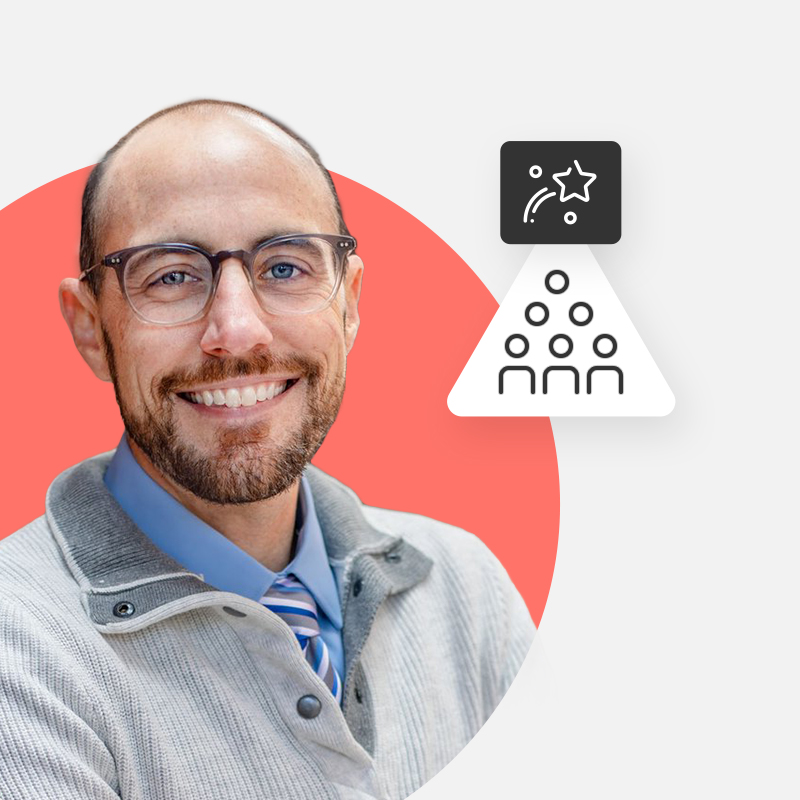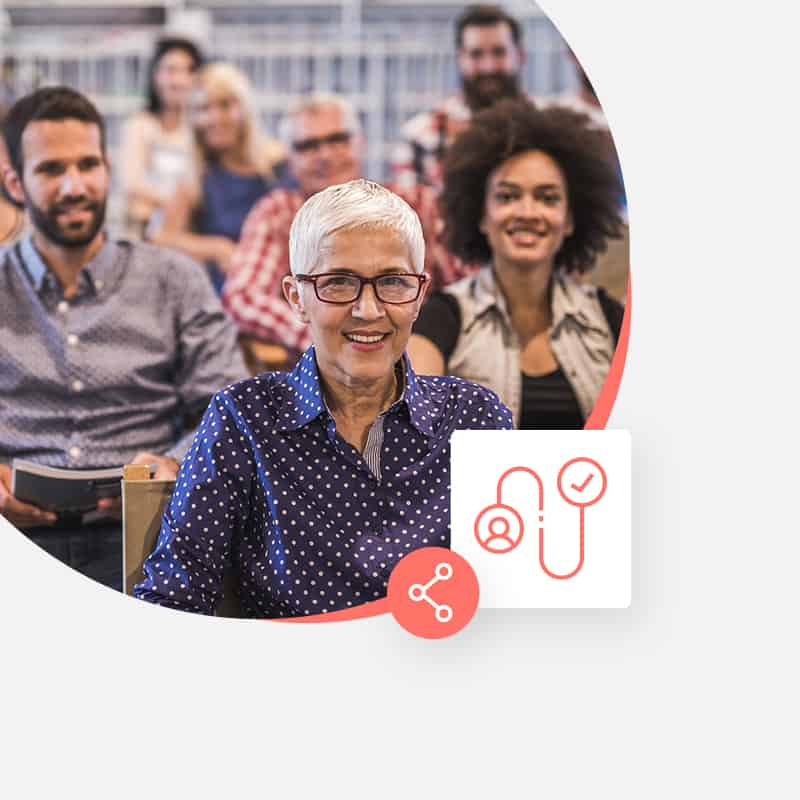Unconscious bias quietly influences our perceptions and decisions, no matter what our intentions are. Because we aren’t aware of these biases, exploring real-life unconscious bias examples can help understand how these hidden prejudices manifest inside organizations.
There’s no reason to feel guilty about unconscious biases. “We are all biased,” says Caitlin Collins, an organizational psychologist and program strategy director at Betterworks. “It’s the way our brains work.”
When we better understand why our brains form unconscious biases, we can develop talent management practices that are more effective and objective. Learn more about how unconscious bias is defined, what it looks like in the workplace, and how HR leaders can help employees overcome this challenge.
What is unconscious bias?
Unconscious biases are implicit — they affect our judgment and behaviors without us realizing. ”How we perceive information and adapt our behavior to achieve a goal, whether the goal is known or unknown, is where bias comes in,” Collins says.
Unconscious bias is a byproduct of our brain’s tendency to process large amounts of information into overly simple (and often stereotypical) pieces of information. The human brain creates mental shortcuts to help us process our thoughts and observations. These categorizations allow us to process large amounts of information quickly.
“Our brains are very efficient machines,” Collins says. “They are designed to create solutions that diminish uncertainty — especially when achieving a goal.”
The downside is that this method of processing information often produces bias. Stereotypes, for example, generalize arbitrary traits of a few members to an entire group. This is, in theory, efficient, but it also leads to sweeping assumptions that often are untrue, unfair, and harmful.
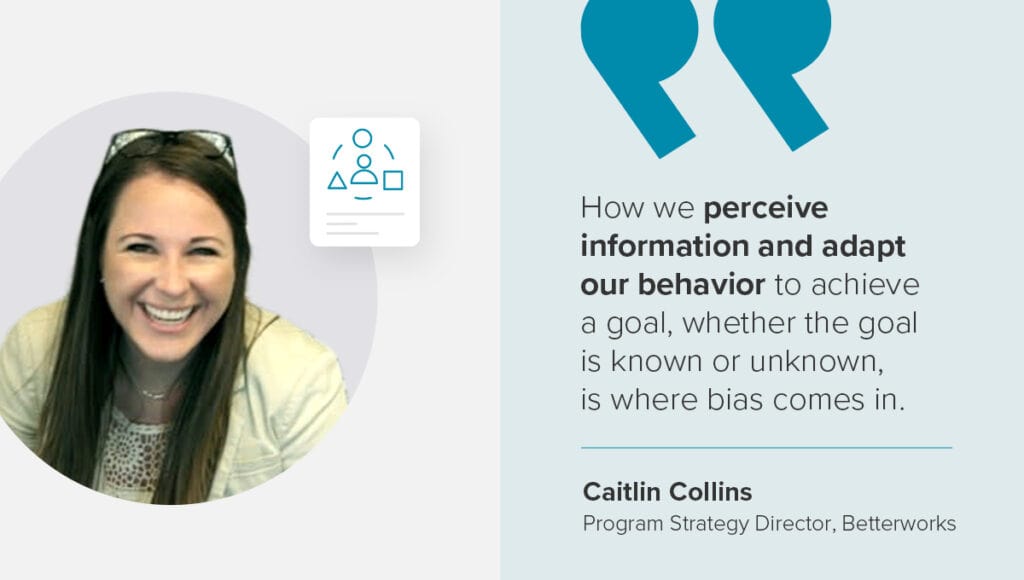
Why is unconscious bias important?
Left unchecked, unconscious bias can have a detrimental impact on your workforce.
One of the worst consequences of unconscious bias is the tendency to unquestioningly believe our brain’s assumptions. And when we believe something without questioning it, we’re more likely to act on that assumption, regardless of its merit.
Unconscious bias can create real harm. Because bias-influenced assumptions aren’t evidence-based and are often incorrect, acting on them can produce unfair outcomes. In our society, unconscious bias perpetuates inequalities in housing, education, healthcare, criminal justice, and other critical areas.
Acting on biases at work can adversely impact historically marginalized groups. For example, when we act on unconscious racial or gender bias during the hiring process, we risk passing over candidates who are objectively the best fit for the role. Why? Because unrelated characteristics or beliefs prompted us to make assumptions about that person, and we prioritize those over more relevant information.
This outcome is unfair to qualified candidates who are passed over and to employees whose ideas and work aren’t appropriately valued within the company culture.
Unabated unconscious bias can also lead to legal trouble. Employers must provide clear, job-related reasons for why they advance some candidates but not others. But if a hiring manager passes over a candidate with a disability because their unconscious bias leads them to mistakenly conclude the candidate is inherently incapable of performing the role, the company could be open to a discrimination claim.
4 factors contributing to implicit bias
Your organizational culture and success is greatly affected by whether leaders act on implicit biases. Understanding the contributing factors can help you take control of them. Discover four factors that could be influencing unconscious bias in your organization.
Cultural norms and expectations
Your culture reinforces attitudes, norms, and values that can intensify or mitigate the effects of unconscious bias. If your culture is more likely to recognize and promote younger employees, for example, age-based employment and promotion decisions are more likely to become ingrained.
A carefully crafted culture can reinforce positive norms, too. For example, rewarding inclusive behaviors demonstrates the company’s emphasis on diversity, inclusion, and equity in the workplace.
Governance and processes
Governance consists of the structures, policies, and procedures that guide your organization’s management. One manifestation of unconscious bias in business governance is the underrepresentation of women and minority groups on corporate boards. One way this bias manifests is in a preference for candidates who align with stereotypes about board membership or whose backgrounds and experiences are similar to existing board members.
Leaders’ attitudes and behaviors can have a significant impact on unconscious bias and governance. An organization’s governance will vary greatly depending on whether leaders acknowledge that biases can affect judgment and implement bias-interrupting processes.
Visibility is essential here, too. If you lack diversity across the organization, you’ll have fewer perspectives and diverse voices. This lack of visible diversity can reinforce people’s implicit biases, continuing the cycle.
Your people processes should specifically address unconscious bias. Checkpoints in the hiring process, for example, can help recruiters stop and consider their decisions more objectively.
Personal background
Everyone comes to work with their own preconceptions, which often manifest as unconscious bias. Workplace education is vital because biases are often the result of what we’ve learned from the people closest to us.
To counter the effects of bias, consider unconscious bias training and other methods that help employees recognize their preconceptions and how they affect decision-making.
Social stereotypes
We’re bombarded with stereotypes from our culture and norms. People with insular backgrounds who are less exposed to differences can be especially vulnerable to believing these stereotypes. While you can’t control what employees experience before joining your organization, you can provide education and help them shift their mindset.

4 unconscious bias in the workplace examples
While it’s important to educate your workforce on the question of what is unconscious bias, examples are another way to help them understand what this looks like — and why it matters.
Check out these examples of implicit bias in the workplace to see what bias looks like in action — and how it could be affecting your talent decisions.
Affinity bias
Affinity bias, also known as similarity bias, describes a bias toward people who are similar to us. “This means we favor and connect with those who are more like us in personality, education, and culture, and have neuro-similarity,” Collins says. “We connect to things we understand.”
Affinity bias can heavily influence our hiring, promotion, and talent development decisions. “For example, we might think, ‘We need to hire and promote salespeople who are extroverted,’ because it’s a trait that we understand and see in ourselves,” Collins continues. “However, there is no correlation that shows extroversion makes a good salesperson.”
Contrast effect
The contrast effect is a common bias that affects how we value or see things based on comparing them to something else rather than based on their own merits.
For example, managers might unknowingly compare each employee against a top performer instead of using fair and equal standards. Unfair comparisons can lead to unfair judgments, as leaders overestimate some people’s performance and unjustly criticize other people’s. This can negatively affect how teams work together and how people feel about their work.
Halo effect and horns effect
The halo effect occurs when one factor that you perceive as positive overshadows all other factors. The horns effect, by contrast, occurs when one factor you perceive as negative dominates your decision-making.
The halo effect in action might look like a hiring manager favoring a candidate who graduated from the same college — even when that coincidence has no impact on their potential in the role. An example of the horns effect is a manager who unfairly docks an employee’s overall performance rating because one aspect isn’t up to par.
Recency bias
Recency bias refers to the tendency to remember recent events and give more weight to them. “Recency bias means we address behaviors based on what we most recently remember,” Collins says. “This is especially prevalent during annual performance reviews.”
Managers might spend more time talking about a recent negative performance outcome, for example, than the employee’s previous months of good performance. “People show up performing every day,” Collins continues, “and it would be inaccurate to assess someone based on their last project or outcome.”
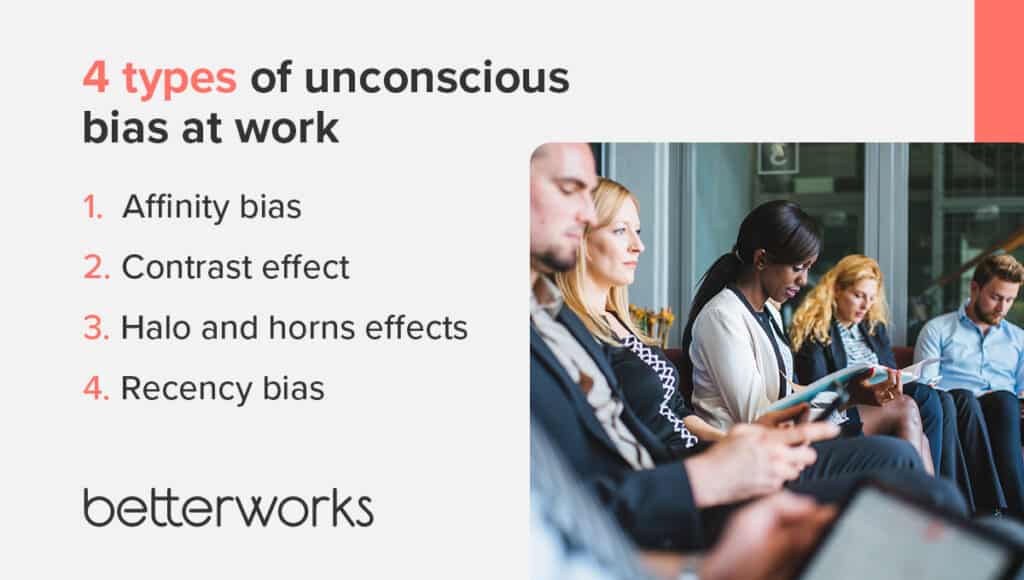
How does unconscious bias affect your organization?
Although unconscious bias isn’t intentional, acting on our biases can still have severe consequences for the workforce and the business. Here are some ways unconscious bias can show up in your organization.
Diversity and inclusion
One obvious consequence of implicit bias is creating a homogeneous workforce. “Sometimes our autopilot leads us in the right direction, but other times, it leads us to favor familiarity over novelty, impacting diversity in our organizations,” Collins says.
For example, unconscious bias by recruiters and hiring managers can favor the dominant traits and personalities within the workforce instead of potential team members with different experiences and perspectives. “For instance, if a hiring manager unconsciously favors candidates who went to the same school or share the same hobbies, they may inadvertently shut out other equally — or more qualified — candidates simply because they don’t fit that familiar mold,” Collins says.
Decision-making
Unconscious biases can impair our ability to make judgment calls. “Imagine you’re the manager trying to determine a fair salary for a well-deserving internal candidate,” Collins says. “Your mental autopilot, influenced by your past experiences, leads you to conclude that a large pay increase would be unfair because it’s more than you ever received.”
Because we’re often not aware of our assumptions, making choices based on those assumptions creates problems. “This form of bias impacts the objectivity of your decision-making process, affecting fairness and morale in the organization,” Collins says.
Workplace culture
Biases affect our behaviors, which means they influence workplace norms and culture. Left unchecked, unconscious bias can create an unhealthy and low-morale environment for many workers.
“We favor those who are similar to us in their looks, beliefs, or backgrounds — and may inadvertently create a culture where those who don’t ‘fit the mold’ feel excluded,” Collins says. When diverse teams and employees feel they have to conform to succeed, they’re more likely to disengage or resign.

Performance and productivity
Annual performance reviews are especially likely to be negatively influenced by recency bias. “Think about recency bias as the final stretch of your journey — it’s fresh in your mind, but it doesn’t represent the entirety of the trip,” Collins says. “Our trip — or an employee’s performance — should be assessed in its entirety, not by the last turn we made.”
Performance reviews subject to recency bias tend to be skewed, and typically not in the employee’s favor. A skewed performance review can harm future performance, too. “It fails to take into account their overall contributions, thus potentially demotivating them and impacting productivity,” Collins says.
Legal compliance
Acting on unconscious biases increases the risk of legal or regulatory noncompliance, which can spell big trouble for any business. “Unconscious biases can lead us to unintentional violations, like speeding in a school zone because we’re used to the pace of the highway,” Collins says. “In a workplace context, these biases may lead to discriminatory practices that violate employment laws, resulting in legal repercussions.”
Consider a manager who consistently selects younger candidates for positions requiring technological skills with the assumption that youth correlates to tech savvy. This action, driven by unconscious bias and stereotypes, discriminates against older applicants by denying them equal opportunities based on age rather than on their actual abilities.
Mitigating the effects of bias in your workforce, by contrast, can prepare your business for success.
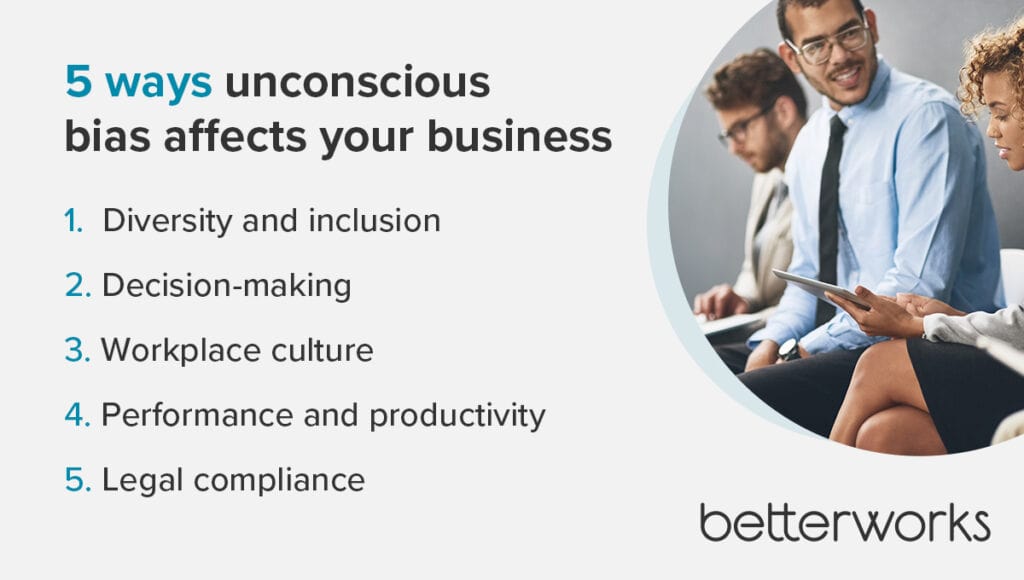
4 tips for managing unconscious bias
It’s tough to manage something you aren’t aware you have, but there are steps you can take, at an organizational level, to dispel biases and incorrect assumptions about others. Explore these practical tips for effectively managing unconscious bias, fostering inclusivity, and creating a more equitable environment at work.
Work to understand people who are different from you
Learning about people who are different from us — whether that’s a different gender, race, culture, orientation, or something else — can help us recognize where our assumptions aren’t true.
Getting to know neurodiverse colleagues, for example, can give us perspective on behaviors that might otherwise seem unusual to us. “A person with ADHD may struggle with executive functioning skills and focus,” Collins wrote in a Fast Company article on recency bias. “A person with autism may struggle with social cues, sensory processing, and flexibility.”
The manager-employee relationship is crucial for helping leaders counter their biases. “Effective leaders make a point of understanding individual employees in greater depth,” Collins continued in the article. “They want to make people on their team be more successful.”
Getting to know someone else helps us see things from their perspective, which can help us avoid biased decisions.
Identify-specific examples of workplace unconscious bias
One of the best ways to avoid unconscious bias is to understand how it operates in your workplace, including in operational processes. Because people can also struggle to question the status quo, processes are a common ground for biases.
For example, consider which types of employees historically are most likely to receive raises or promotions. Who is most rewarded in your organizational structure and culture? “To improve our biases, we need to reflect on these types of situations,” Collins says. “When you take the time to think the situation over and what you would do differently, that is the start of behavior change.”
Revisiting real-life scenarios through the lens of unconscious bias can help us identify where bias is creeping into our behaviors and decisions. Practicing mindfulness, meanwhile, can help us consider our actions more intentionally so we can change our behaviors over time.
“Mindfulness is not just a buzzword,” Collins says. “It actually increases our neuroplasticity.”
Neuroplasticity refers to the brain’s ability to reorganize and adapt by forming new neural connections throughout life. It involves the brain’s capacity to modify its structure, function, and networks in response to learning, experiences, and changes in the environment. Essentially, we’re “rewiring” our brains to minimize biases and incorrect assumptions.
Invest in unconscious bias training
Although there’s no way to eliminate the biases hardwired into our brains, we can take steps to mitigate their effects.
Much of this progress depends on learning. The more aware we are of our biases, the less likely we are to act on them or let them control us. The right training program can help you change your mindset.
Good training programs are actionable and focus on the future. They help employees recognize where bias has affected their judgment while offering solutions for overcoming its effects going forward.
While training and awareness help, one of the most powerful ways to minimize the impact of unconscious bias is by getting exposure to people who are different from us. The more one-on-one interactions we have with someone, the more likely we are to see that person as a complete and unique individual rather than as a stereotype. That recognition can go a long way toward changing biased thought processes.
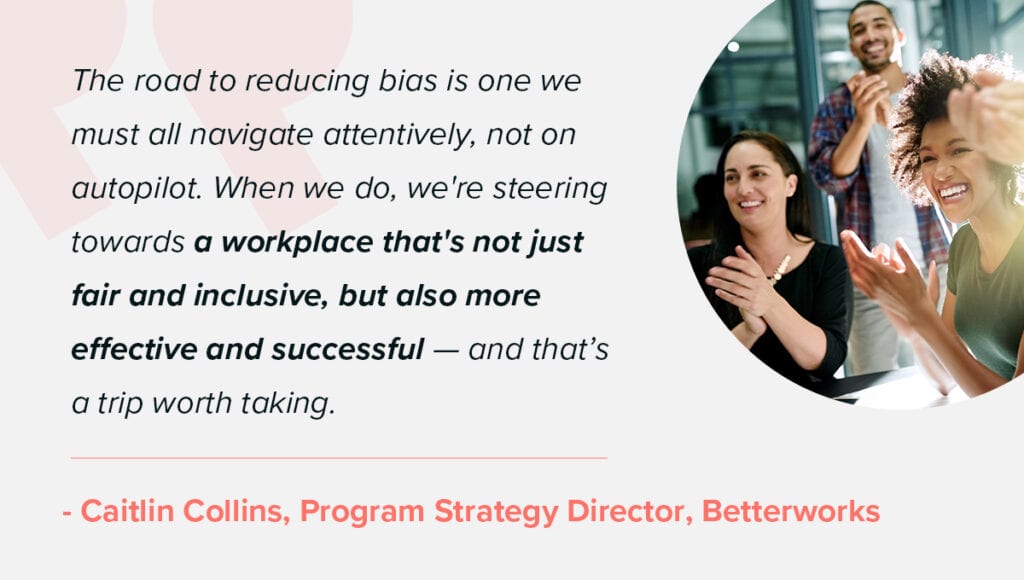
Build safeguards into your processes
The best way to interrupt the effects of bias before they harm the workforce is to create processes that leave little to no room for bias to intrude.
For example, because name bias can cause recruiters to favor certain candidates’ applications over others’, removing names from applications reduces this likelihood. Instead, recruiters must look at skills, abilities, and other traits that actually influence future performance.
Hiring assessments can help recruiters and hiring managers select candidates who are objectively best-suited for the role. Assessment tools that are valid, reliable, and fair result in better hiring decisions and provide legal defensibility against discrimination claims.
The data you gather from assessments can be compared with what’s required for the role via an objective scorecard. The candidates that score highest are, objectively, the best fit for the role — regardless of their personal identifying factors, such as race or socioeconomic background.
Similarly, using set interview questions prevents hiring managers from going off-script, which can cause them to elicit information about identifying traits they don’t need to know. Fixed questions that correspond to specific skills or experiences (“Tell me about a time when …”) will prompt more applicable responses and contribute to a more objective hiring decision.
During the employee life cycle, intentional performance enablement practices put guardrails around feedback and promotion criteria. When managers are trained on giving effective feedback and held accountable in their own performance appraisals, unconscious biases are less likely to affect results.
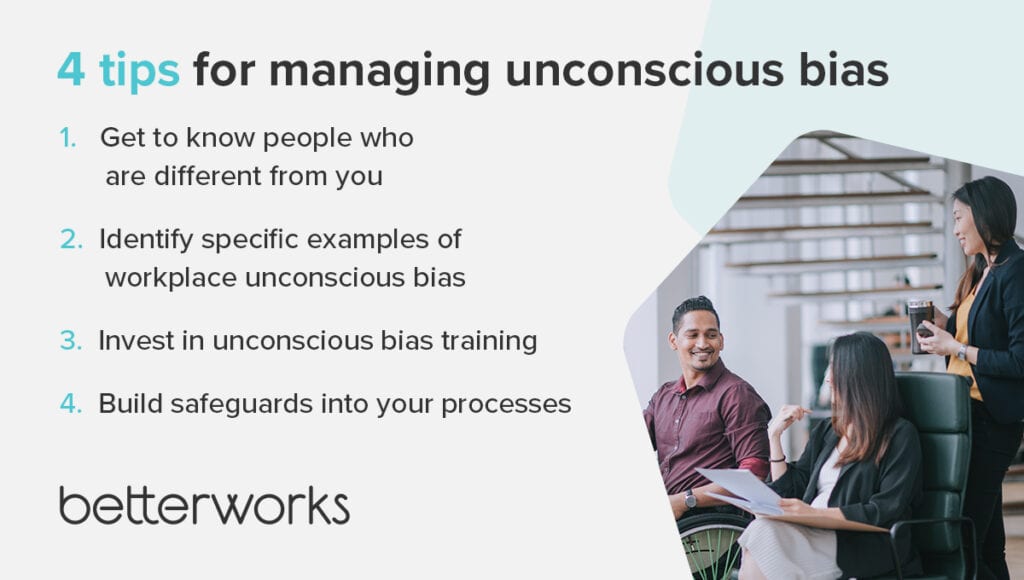
Applying unconscious bias examples
When you consistently view your work decisions and processes through the lens of unconscious bias, you can learn how to apply these examples in your daily actions. Changing your mindset about unconscious bias is important, but changes in thinking must be followed by actions.
Overcoming unconscious bias is a journey. Set out with intention, and create a road map that shows how the organization, from HR to leadership to the front lines, will overcome the effects of unconscious bias and produce a more inclusive workplace.
“The road to reducing bias is one we must all navigate attentively, not on autopilot,” Collins said. “When we do, we’re steering towards a workplace that’s not just fair and inclusive, but also more effective and successful — and that’s a trip worth taking.”
Want to learn more? Find out how to reduce bias in performance management.
Reducing Bias in Performance Management


